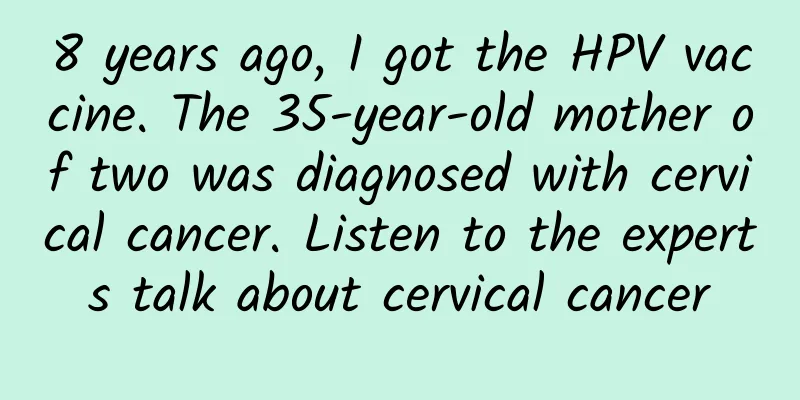8 years ago, I got the HPV vaccine. The 35-year-old mother of two was diagnosed with cervical cancer. Listen to the experts talk about cervical cancer

|
Cervical cancer is the most common malignant tumor of the female reproductive system. Globally, there are more than 600,000 new cases of cervical cancer each year, and about one woman dies from cervical cancer every two minutes. The development of cervical cancer is a long process. If screening can be carried out in the early stage of the disease, the occurrence and development of cancer can be prevented. The focus of cervical cancer screening is to detect precancerous lesions in the period without subjective symptoms, and to conduct clinical diagnosis and treatment as early as possible, so as to prevent and stop the occurrence of cancer. Today, we invited Professor Lv Weiguo, Secretary of the Party Committee of the Obstetrics and Gynecology Hospital Affiliated to Zhejiang University School of Medicine, to talk to us about cervical cancer. Lv Weiguo: Secretary of the Party Committee of the Obstetrics and Gynecology Hospital Affiliated to Zhejiang University School of Medicine, professor, chief physician, doctoral supervisor, enjoys the special government allowance of the State Council, and is a young and middle-aged expert with outstanding contributions from the National Health Commission. Leading talent in Zhejiang Province's health, outstanding talent in Zhejiang Province's "Ten Thousand Talents Plan". Distinguished physician of Zhejiang University Qiushi. Leader of the National Regional Medical Center for Obstetrics and Gynecology (construction unit). Leader of the national key R&D project "Research on new technologies and programs for cervical cancer screening and intervention". Director of the Zhejiang Province Uterine Malignant Tumor Diagnosis and Treatment Technology Research Center, Chairman of the Obstetrics and Gynecology Branch of the Zhejiang Medical Association. He has been engaged in clinical and basic research on gynecological tumors for a long time, and has carried out scientific research and clinical new technology promotion in the fields of cervical cancer prevention and treatment, ovarian cancer diagnosis and treatment, endometrial cancer diagnosis and treatment, and individualized humanized fertility and physiological function preservation treatment for young patients with malignant tumors, and has achieved outstanding results. He led the project "Research on New Technologies and Programs for Cervical Cancer Screening and Intervention", established a cervical cancer screening database for the Chinese population, and displayed the prevalence data of HPV infection and subtype distribution in different regions of my country; developed a high-throughput miRNA detection kit for cervical exfoliated cells based on RNA molecular markers, and completed large-scale population verification; and compared the kit with the first-line and primary screening tool cobas kit in the United States to prove its screening efficiency, effectively promoting the localization process of HPV kits. The related results won 1 first prize for scientific and technological progress from the Ministry of Education and 2 national invention patents, which has great scientific value for formulating cervical lesion screening strategies that meet my country's national conditions. Getting the HPV vaccine doesn't mean everything is OK HPV virus is the culprit of most cervical cancers. HPV vaccine can effectively prevent cervical cancer. Therefore, the "Global Strategy to Accelerate the Elimination of Cervical Cancer" issued by the World Health Organization advocates that countries: by 2030, 90% of girls should complete human papillomavirus vaccination before the age of 15. But getting the HPV vaccine doesn’t mean everything will be fine. The 14 common high-risk HPV viruses can cause about 90% of cervical cancer, but the current vaccine cannot fully cover all high-risk HPV virus types, so cervical cancer screening is also essential after completing the HPV vaccination. Some time ago, the Obstetrics and Gynecology Hospital affiliated to Zhejiang University School of Medicine received a patient who unfortunately got infected after receiving the HPV vaccine. Ms. Li, 35, usually pays great attention to her health care. As early as 8 years ago, she went to Hong Kong to receive the HPV vaccine, thinking that this would completely keep her away from cervical cancer. Last year, she was diagnosed with uterine fibroids after giving birth to her second child, and has been undergoing regular follow-up visits. During an ultrasound examination, doctors at the local hospital found that her uterine mucosal cavity was enlarged and had abundant blood supply, and highly suspected cervical cancer. She was then transferred to the Department of Obstetrics and Gynecology, Zhejiang University School of Medicine, for a cervical canal biopsy, and was eventually diagnosed with cervical cancer. HPV vaccination and cervical cancer screening are two indispensable links in preventing cervical cancer. For young girls, vaccination is more meaningful; for adult women, vaccination and regular screening are both important. If both HPV and cervical cytology tests are negative, a physical examination can be performed every 3-5 years. In addition, patients with symptoms such as abnormal vaginal discharge and bleeding during intercourse should go to a regular hospital for a gynecological examination even if the screening is negative, so as to avoid missing rare non-HPV-related cervical cancer. The cause of cervical cancer is relatively clear Regular cervical cancer screening is important There are two characteristics of cervical cancer: First, the cause is relatively clear. The cause of cervical cancer is high-risk HPV infection. Of course, after the cause of this cancer was identified, humans have developed the first preventive vaccine for cancer, which is the HPV vaccine. This is also what we often call primary prevention. Vaccination can prevent high-risk HPV infection and eliminate cervical cancer from the source. Of course, this is for cervical squamous cell carcinoma. The causes of other non-cervical squamous cell carcinomas are relatively more complicated. Second, there are very obvious precancerous lesions. The occurrence of cervical squamous cell carcinoma must go through precancerous lesions. Therefore, we use secondary prevention, that is, to detect precancerous lesions through screening. Precancerous lesions screened out can achieve the goal of eliminating cervical cancer through correct and standardized treatment. It is important to note that HPV vaccination cannot replace cervical cancer screening. After taking the HPV vaccine, regular cervical cancer screening is still required. The significance of cervical cancer screening is that it can be prevented, detected early, and treated early. HPV infection usually does not require treatment Human papillomavirus (HPV) is closely related to the occurrence of cervical cancer. The Expert Consensus on Immunization Prevention of Human Papillomavirus-Related Diseases such as Cervical Cancer points out that HPV infection is mainly transmitted through sexual behavior, and its infection rate mainly depends on the age and sexual behavior habits of the population. There are two peaks in my country: The HPV infection rate in the cervix is highest in young sexually active women, with the peak infection age at around 20-25 years old. The cervical HPV infection rate decreases significantly with age. Data from my country's large-sample population-based epidemiological surveys show that there is a second HPV infection peak in Chinese women, at around 40-45 years old. On the one hand, this is related to the fact that the immune function of older women decreases with age, and their ability to clear new and past infections decreases, making them more susceptible to persistent infection. On the other hand, it may be related to infection through contact between themselves or their spouses and new sexual partners. HPV infection is related to sex, but it should be noted that sexual contact is not the only factor. There may be other ways to cause HPV infection in the human body. Although most cervical cancers are caused by HPV infection, this does not mean that HPV infection will definitely develop into cervical cancer. 90% of people will experience reversal within a certain period of time after infection, that is, HPV will be cleared by the human immune system and will not cause long-term harm. In addition, there is currently no clear-cut drug for the treatment of HPV infection, so HPV infection generally does not require treatment. HPV accurate screening can screen out people at high risk of cervical cancer HPV precision screening, whose full name is HPV typing and integration detection, is a detection method that uses liquid probe hybridization capture and high-throughput sequencing to capture and sequence the 18 common and pathogenic subtypes of HPV, clarify the specific typing of HPV infection, and analyze whether the virus is integrated with the genes of the infected person. This test is as simple and non-invasive as our daily cytology examination method. It requires patients to come to the hospital for a gynecological examination by a doctor during the non-menstrual period, without sexual intercourse or vaginal medication within 48-72 hours. A special sampling brush is used to collect exfoliated cells from the cervix, which are then stored in cell preservation fluid for examination. This test is mainly used to estimate the risk of some patients with abnormal cervical screening results. Therefore, strictly speaking, this is a more advanced screening method. Through such a test, it can help both doctors and patients better understand the patient's viral infection status, estimate the patient's risk of future lesions, and the risk of worsening and malignant transformation in patients who already have mild lesions. Accurate screening of HPV integration status is to accurately check whether the HPV genome has integrated with the genome of the infected person, so as to risk stratify high-risk HPV-infected people, guide high-risk people to timely diagnosis and treatment, and low-risk people to follow up on time, and formulate personalized treatment, follow-up, and reexamination plans for people at different risks. Cervical cancer screening is also recommended during pregnancy Data from the Global Cancer Yearbook show that among malignant tumors occurring during pregnancy, cervical cancer ranks second only to breast cancer. In recent years, the incidence of cervical cancer during pregnancy has also increased significantly due to the younger onset of cervical cancer, the delay in women's desire to become pregnant, and the opening of my country's three-child policy. In some developed countries such as the United States and France, almost all pregnant women undergo routine cervical cancer screening during pregnancy; however, the popularity of this examination in China needs to be improved. For example, the number of cervical cancer screenings during pregnancy in Zhejiang Province is less than 1% of the total number of pregnant women. To this end, the Obstetrics and Gynecology Hospital Affiliated to Zhejiang University School of Medicine has specially opened a clinic for screening cervical diseases during pregnancy to provide targeted examinations and treatments for pregnant women who are planning to have children or are already pregnant. There are three main purposes of cervical screening during pregnancy: First, detect invasive cervical cancer early and adopt individualized treatment according to different conditions; Second, if cervical precancerous lesions are found, the frequency of monitoring and postpartum treatment plans will be determined according to the severity; Third, if there is high-risk HPV infection or cervical precancerous lesions during pregnancy, the rate of premature birth or miscarriage will increase. Therefore, pregnancy management should be strengthened for such pregnant women, and the length of the cervical canal should be monitored regularly to avoid miscarriage and premature birth and improve perinatal prognosis. Who needs cervical cancer screening during pregnancy? Domestic and foreign diagnosis and treatment guidelines unanimously recommend that pregnant women who have not undergone cervical cancer screening within one year before pregnancy should undergo cervical cancer screening during pregnancy or after delivery. The recommended time for the first screening is 12-26 weeks of pregnancy. Of course, after 20 weeks of pregnancy, the stability of the uterus increases and safety is more recommended. If you miss the cervical cancer screening during pregnancy, 42 days after delivery is still a good time for screening. The recommended screening method is combined screening of cervical cytology and high-risk HPV. Are there any risks in cervical cancer screening during pregnancy? A large amount of clinical data shows that cervical cancer screening during pregnancy is very safe and will not cause serious complications such as miscarriage, premature birth or infection. A large-sample retrospective study from China also found that the main complication of cervical cancer screening during pregnancy is a small amount of vaginal bleeding, with the amount of bleeding being only 5-20 ml. Bleeding can be stopped by local pressure for 5-10 minutes, and no serious pregnancy complications occur - therefore, cervical cancer screening during pregnancy is safe and reliable. Lin Lin, reporter of Orange Persimmon Interactive Correspondent Sun Meiyan |
<<: BatteryBox: Survey shows Chrome is the killer of MacBook battery life
Recommend
Is it normal to have sore legs after an abortion?
Many young women do not know how to protect thems...
Women are more likely to get pregnant during those days
Infertility is a very common thing nowadays. The ...
What medicine should women take for hot and cold during menopause
Female menopause is actually a period of rapid ag...
Why does bleeding occur after having sex after the menstrual period ends?
During the menstrual period, a woman's body w...
Are you really fat? Check these three criteria! Healthy "three reductions" to lose weight scientifically
BMI index Weight (kg) / height (m) squared. Accor...
How can young girls solve breast hyperplasia most effectively
Many young girls experience breast pain before me...
Can accessory breast surgery be performed?
Accessory breasts can be treated by surgical remo...
What happened to those people who always wore false eyelashes?
Many female friends are keen on the "three-p...
Is it a big deal if you are at high risk at age?
Nowadays, with the rapid development of medical t...
Why is the vaginal discharge watery and odorless?
Many adult women will suffer from gynecological d...
Can pink acacia flowers be eaten? How to preserve acacia flowers for a long time
Sophora flowers can be used as ornamental plants ...
What are the nutritional values of duck blood vermicelli soup? Who is suitable for duck blood vermicelli soup?
Duck blood is a "scavenger" of human wa...
What to eat to delay menstruation
Menstruation is a normal physiological phenomenon...









